Cold Hardy Palm Trees (With Pictures) – Identification Guide

Cold-hardy palm trees are ideal for planting in a landscape that gets occasional freezing temperatures and some snowfall. Growing cold-hardy palm trees can add a touch of the tropics to your garden landscape. In addition, the elegant trees with their graceful leafy fronds are typically easy to grow. They can significantly enhance your yard’s aesthetic appeal. Therefore, you don’t need to live in a tropical or subtropical climate to grow elegant palm trees in your yard.
The level of cold that hardy palm trees can withstand depends on individual species. Some of the hardiest palm trees perform well in USDA zone 7 and sheltered areas of zone 6. This means that many cold-hardy palms will survive temperatures between 32.4°F and 41°F (0.2°C – 5°C). Some of the cold-hardiest palms survive temperatures as low as 5°F – 0°F ( -18°C to -15°C). However, it’s important to note that cold-hardy palm trees only withstand brief spells of cold temperatures.
This article is a guide to the cold-hardiest palm trees for temperate and subtropical climates. The list of cold-hardy palm trees contains descriptions and pictures of the graceful trees. You will also get helpful tips on where to grow cold hardy palms. Additionally, you’ll get information on minimum temperatures they can survive without suffering extensive damage.
What Are Cold Hardy Palm Trees
Cold-hardy palms are plants from the family Arecaceae that can tolerate short periods of cold temperatures near or below freezing. The species of palm trees that withstand the coldest temperatures are typically from the Washingtonia, Trachycarpae, and Rhapis tribes. In addition, these cold-hardy palms can include fan palms and pinnate-leaved palm trees.
The best examples of cold-hardy palms that tolerate cold temperatures are the windmill palm (Trachycarpus fortunei), European palm (Chamaerops humilis), Pindo palm (Butia capitata), and the stunning Bismarck palm (Bismarckia nobilis).
In addition to withstanding cold temperatures, other factors affecting the cold-hardiness of palm trees include the tree’s age and size, duration of the cold, and relative humidity. Palms—including cold-hardy species—tend to fare better in drier conditions. And older palm trees have a better tolerance for the cold than younger trees.
Can Palm Trees Survive Freezing Weather?
Several species of cold-hardy palms can tolerate freezing conditions. A few temperate-climate palms can survive hard freezes, but only for a brief period. However, freezing weather can kill fronds, causing them to become brown and drop. And if the center of the palm tree trunk freezes, the plant will unfortunately die.
The level of frost damage after a freeze is usually indicated by the amount of brown plant material on a palm tree. After a freeze, palms may have a few brown fronds. But these are typically nothing to worry about. You can remove these to improve the palm’s aesthetic appeal. However, if all the palm tree’s foliage is entirely brown, the palm has suffered irrecoverable frost damage.
Another sign of damage to a palm tree after a freeze is fluid leaking from the main trunk. In this case, removing the tall palm tree is crucial to prevent it from doing damage when it falls.
Types of Cold Hardy Palm Trees (With Pictures) – Identification Guide
Cold-hardy palm trees can turn your landscape into a tropical paradise. Some hardy palms will continue to thrive even in climates that get frost and snow in the winter. The good news is that the cold-hardiest palm trees don’t require much care to protect them from a light frost or short period of snowfall.
Windmill Palm (Trachycarpus fortunei)

The windmill palm tree is a cold hardy and slow growing small palm
The windmill palm is one of the cold-hardiest palm trees. The hardy palm is identified by its fan-shaped leaves growing at the end of straight stems. As an easy-to-grow cold-hardy palm tree, the small evergreen plant is ideal for compact gardens in USDA zones 7 to 11.
The windmill palm can tolerate short cold snaps as low as 5°F (-15°C). Growing in full sun to part shade, the drought-tolerant Chinese windmill palm thrives in fertile, well-drained soils. However, it performs best when protected from cold winds and hard winter frosts.
Hardy Palm Tree Identification
The identifying features of the windmill palm tree are fan-shaped green leaves measuring 3 ft. (1 m) wide, dark blue palm tree fruits, and shaggy bark covered in black fibers.
Cabbage Palm Tree (Sabal palmetto)
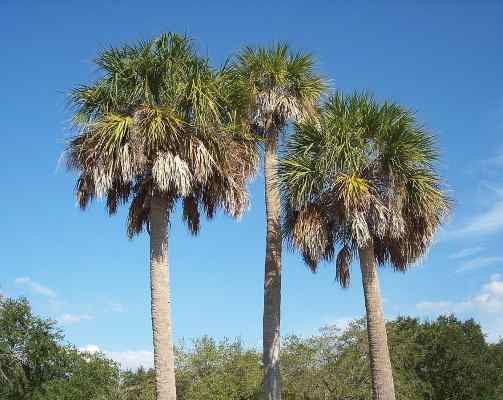
The tall cabbage palm tree can survive cold weather and is one of the cold hardiest palm trees
The cold-hardy cabbage palm tree is a spectacular palm with a crowning mass of large fan-shaped pinnate and palmate fronds. The cabbage palm features a broad, upright, erect trunk that is smooth gray at the base and sometimes shaggy brown from the middle to the crown. This palm grows 40 to 50 ft. (12 – 15 m) tall.
The cabbage palm tree can tolerate freezing temperatures to 15°F (-9°C), making it one of the hardiest palms. This palm is the state tree of Florida, where it’s widely cultivated. The salt and drought-tolerant palm tree grows well along streets, in coastal sands, in groves, or as a specimen plant.
The cabbage palm is ideal for growing in USDA zones 8 to 11, where it enjoys fast growth, adding 12” to 24” (30 – 60 cm) per year.
Hardy Palm Tree Identification
The cabbage palm tree is identified by its large, fan-shaped grayish-green leaves, gray trunk, creamy-white fragrant flowers, and black summer fruits.
European Fan Palm Tree (Chamaerops humilis)

The cold hardy European fan palm tree has few trunks and is small enough to suit many gardens
Also called the Mediterranean fan palm, the multi-stemmed European fan palm is among the hardiest palm trees you can grow. The European fan palm tree has bushy foliage of spiky, blue-green fan-shaped leaves, rough brown trunks, and brown fruits. The small palm tree grows as a small tree or rounded shrub, making it a versatile landscaping pine.
This slow-growing palm grows 6 to 15 ft. (1.8 – 4.5 m) tall and up to 20 ft. (6 m) wide. The European palm thrives in USDA zones 9 to 11 and is cold-hardy to 10°F (-12°C). This palm grows well in coastal areas where it is useful as a foundation plant for front of house, specimen plant, or container palm tree.
The pinnate fronds consist of 10 to 20 stiff leaflets, 24” (60 cm) long, growing in a semi-circle shape at the end of 4 ft. (1.2 m) stems. The European palm blooms in spring with bright yellow flowers, followed by brown dates in the fall.
Hardy Palm Tree Identification
The European palm is a suckering palm tree, identified by its multiple stems, rounded habit, and colossal palm fronds. The rounded shrub-like palm is a fan-leaved, yellow-flowering palm with orange or brown palm fruits.
Saw Palmetto Palm Tree (Serenoa repens)
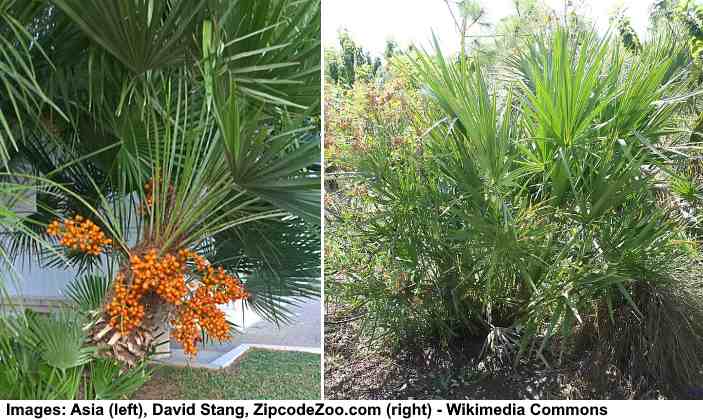
The small saw palmetto palm tree can tolerate freezing conditions and is suitable for limited spaces
The saw palmetto palm belongs on the list of cold-hardiest palm trees because it tolerates temperatures as low as 0°F (-18°C). The slow-growing, clumping palm with its fan-shaped fronds grows 5 to 10 ft. (1.5 – 3 m) tall and wide. Identifying features of the cold-hardy palm are plume-like branched stalks, white blossoms, and yellow-orange berries.
Tolerating climates in USDA zones 7 through 11, the versatile palm tree has valuable ornamental characteristics. You can plant the palm in full sun to full shade and grow as ground cover, a foundation planting, textural accent, or erosion control.
Hardy Palm Tree Identification
The identifiable characteristics of the saw palmetto are waxy, fan-shaped evergreen fronds 3 ft. (1 m) in diameter, up to 30 segments per leaf, and fragrant white summer flowers.
Mazari Palm Tree (Nannorrhops ritchiana)

The Mazari palm tree is a hardy palm that survive both cold and hot weather conditions
The Mazari palm is a clustering palm tree with silvery-blue fan-shaped fronds growing on smooth petioles. The huge stiff, palmate leaves have 20 to 30 leaflets per leaf and grow 4 ft. (1.2 m) wide. The Mazari palm grows to 10 – 20 ft. (3 – 6 m) tall with a spreading crown.
The Mazari palm is one of the cold-hardiest palms performing well in full sun and heat. Mazari palm is hardy to USDA zone 7, meaning it will tolerate temperatures around 5°F (-15°C). In addition, this slow-growing palm tolerates warm, humid environments or cold, dry climates.
Hardy Palm Tree Identification
The Mazari palm survives in extreme heat or cold. It is identified by its stiff, glaucous-green fan leaves, clusters of white flowers, and edible palm fruits that are brown or orange.
Pindo Palm Tree (Butia capitata)
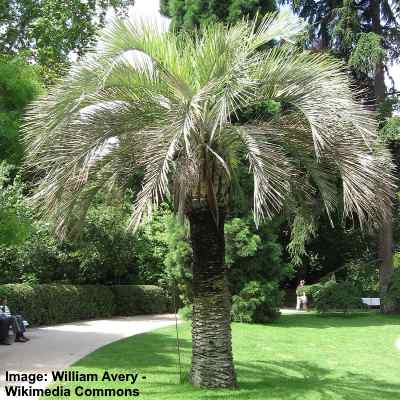
Pindo palm is a slow growing, cold-hardy small palm tree
The pindo palm is a sun-loving, hardy landscaping palm tree with arching fronds, fragrant creamy-yellow flowers, and yellowish-orange edible fruits. Also called the jelly palm, this elegant palm has a weeping appearance with slender pinnately-compound leaves growing on curved stems. Pindo palm trees grow 10 to 20 ft. (3 – 6 m) tall.
The pindo palm is one of the easiest palms to grow. The cold-hardy palm thrives in USDA zones 8 through 11, growing in full sun and sandy, well-drained soil. This attractive landscaping palm tree is tolerant of drought, salt, heat, and cold down to 14°F (-10°C).
Due to its attractive shape, curved petioles, and bluish-green or grayish-green leaves, the palm is best used as a specimen plant.
Hardy Palm Tree Identification
The identifying features of the pindo palm are its arching palm leaves growing 3 to 6 ft. (1 – 1.8 m) long, sweetly-scented white flowers on dangling spikes, and sweet, large dates that taste of pineapple.
Dwarf Palmetto (Sabal minor)
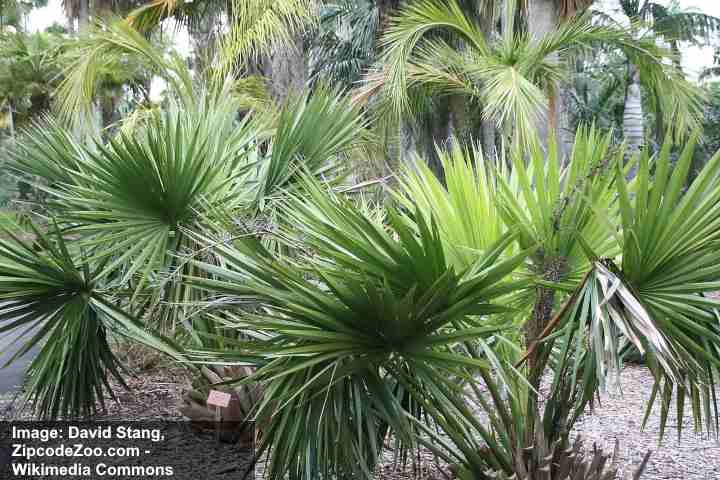
Dwarf palmetto can be found in many habitats and is a cold hardy small palm
Also called bush palmetto or scrub palmetto, this dwarf palm is a low-growing palm plant that is hardy to 10°F (-12°C). Not growing more than 6 ft. (1.8 m), this landscaping palm has blue-green, fan-shaped leaves growing 3 ft. (1 m) in diameter.
Other characteristics of the ornamental dwarf palmetto palm include exceptionally fragrant clusters of white flowers, small brown to black palm fruits, and an attractive appearance. Dwarf palmetto is also tolerant of coastal conditions and drought. Plant in full sun or partial shade as a ground cover or front-of-house foundation plant.
Hardy Palm Tree Identification
The hardy dwarf sabal evergreen palm has a short trunk or is sometimes trunkless. The palm’s identifying features are its fan-shaped, shiny dark-green leaves, white flowers, and small black fruits.
Chinese Fan Palm Tree (Livistona chinensis)
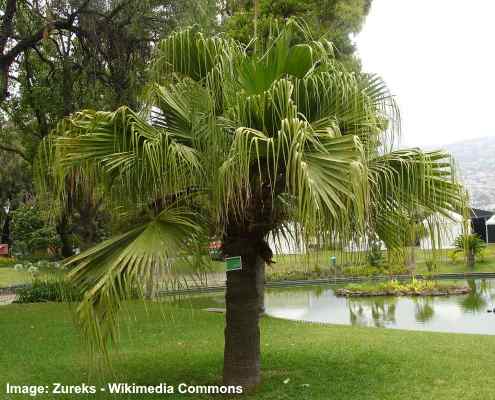
The ornamental cold-tolerant Chinese fan palm looks attractive in any landscape design
The Chinese fan palm tree is a cold-hardy, medium-sized evergreen palm with a broad, large canopy of drooping emerald-green fronds. Each palm leaf has up to 50 long, slender leaflets growing 3 to 6 ft. (1 – 1.8 m) long. The stiff spine-covered stems are sharp and jaggy.
Cold-hardy Chinese fan palm tree tolerates cold snaps down to 15°F (-12°C), making it among the hardiest palms you can grow. The upright palm with its slender trunk and weeping emerald-green foliage thrives in USDA zones 9 to 11. Growing 10 to 30 ft. (3 – 9 m) tall, the elegant palm is ideal as a specimen tree.
The exotic-looking, drought and salt-tolerant palm tree is easy to grow in most landscapes.
Hardy Palm Tree Identification
The Chinese fan palm tree has a smooth, gray-brown trunk, drooping fan-shaped leaves growing up to 6 ft. (1.8 m) long, huge clusters of creamy-white flowers, and dark blue palm fruits.
Blue Hesper Palm Tree (Brahea armata)
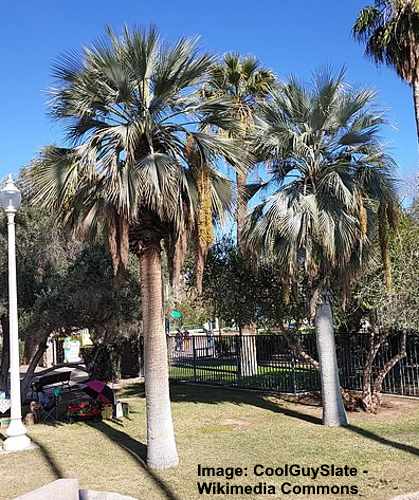
The hardy blue hesper palm tree can survive short freezing conditions
Also called the Mexican blue palm, this elegant palm tree has a single, erect trunk, and spectacular bluish-green fan-shaped leaves 5 ft. (1.5 m) long. The characteristics of this hardy palm are its large fronds with 40 pointed segments, leaf stems 3 ft. (1 m) long, yellow flowering clusters 15 ft. (4.5 m) long, and yellow fruits.
The cold-hardy blue Hesper palm tree is resistant to brief freezing temperatures of 18°F (-8°C). The tall palm with its fibrous trunk grows 20 to 40 ft. (6 – 12 m) tall and up to 25 ft. (7.5 m) wide. The full-sun palm tree tolerates poor soil and dry conditions and is drought tolerant when established.
Hardy Palm Tree Identification
The blue Hesper palm tree is identified by its dramatic blue-green spiky leaves, stunning clusters of yellow flowers, and yellowish fruits measuring 1” (2.5 cm) long.
Bismarck Palm Tree (Bismarckia nobilis)

The small Bismarck palm tree has beautiful silvery gray foliage and it tolerates short frosty conditions
The Bismarck palm tree is one of the most spectacular cold-hardy landscaping palms. The evergreen palm tree features a thick trunk with silver-blue fan-shaped fronds. The thick, curved stems growing 4 ft. (1.2 m) long have stiff leaflets. These create a broad, rounded head of attractive palm leaves.
Bismarck palm trees can survive brief frost periods as low as 20°F (-6°C). However, more mature palms are even cold-hardier. The drought-tolerant palm is suitable for xeriscaping in hot, dry climates. However, Bismarck palms also tolerate freezing conditions. It’s ideal as a lawn plant, specimen plant, or to line driveways.
Hardy Palm Tree Identification
The Bismarck palm tree is easy to identify due to its stunning silvery-blue stiff fronds, robust thick trunk, and clusters of large brown fruits measuring 1.5” (3 cm) long.
Needle Palm (Rhapidophyllum hystrix)
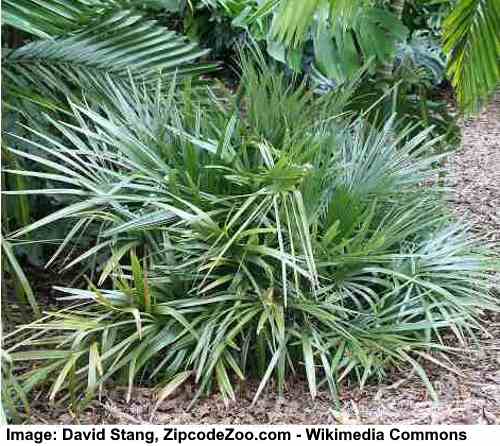
Needle palm is cold hardy and can grow as a miniature patio palm
The needle palm tree is a shrub-like palm with several short trunks growing from the ground. The needle palm is one of the cold hardiest palm trees. It is hardy to 5°F (-15°C) and thrives in zones 6 through 10.
You can identify this native Florida palm by its thick trunk and fronds growing in a fan shape that creates a rounded crown on the palm. This small hardy palm tree grows between 3 and 6 ft. (1 – 1.8 m) tall with a spread of up to 8 ft. (2.4 m).
Needle palms are suitable for small spaces. The bushy palms also grow well in containers as an ornamental low-growing tree or specimen plant.
Hardy Palm Tree Identification
Identify the short needle palm by its clumping growth of fan-like leaves, stout trunk, and rounded growth.
Guadalupe Palm (Brahea edulis)

The small and slow growing Guadalupe palm is a popular landscaping tree
The Guadalupe palm tree is a small cold hardy palm plant with fan-shaped leaves growing on the stems, a rough, brown fibrous solitary trunk, and sweet black palm fruits. Guadalupe palms grow 15 to 40 ft. (4.5 – 12 m) tall and are a slow-growing palm type.
The Guadalupe palm tree is suitable for USDA zones 9a – 11. It is hardy to around 20 °F (-6.6 °C) before it needs protection.
The distinctive feature of the Guadalupe palm is the stiff leaflets growing in the shape of a fan at the end of long smooth stems. In the landscape, these palm trees make a dramatic statement due to the spiky appearance of the dense crown. As a result, the ornamental palm is a popular landscaping palm tree in California.
Hardy Palm Tree Identification
You can identify Guadalupe palms in the summer due to their fragrant, creamy yellow blooms growing in amongst the foliage. After flowering, the palm produces deliciously sweet palm fruits that you can eat fresh or use in cooking.
California Fan Palm (Washingtonia filifera)
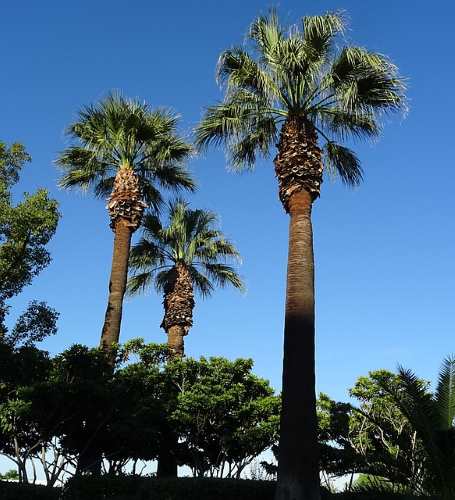
The cold hardy ornamental California fan palm is identified by its fan shaped fronds
The California fan palm is a cold-tolerant medium-sized ornamental palm tree with long, fan-shaped fronds with fibrous threads and a sturdy columnar trunk. The palm tree is hardy to USDA Zones 8b – 11 and can tolerate freezing conditions of 15 to 20ºF (-9.4 to -6.7ºC) with minor damage to the foliage.
The identifying feature of the California fan palm is its spectacular leaves made up of waxy green blades that spread out in a fan shape. This palm tree grows between 40 and 60 ft. (12 – 18 m) tall.
Other identifying features of the California fan palm are its grayish and tan trunk that stands erect. In addition, it’s easy to recognize California palms due to the skirt-like shape of dead fronds near the top of the tree. After the gray-green leaves die, they droop down and turn brown.
Hardy Palm Tree Identification
You can identify California fan palm tree by its tall and straight trunk and thread-like strands on the green palmate leaves. The recognizable fan shape of the leaves also gives it the name desert fan palm.
Mexican Palm tree (Washingtonia robusta)
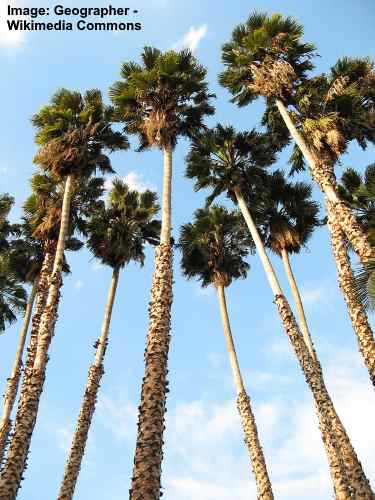
The Mexican palm is relatively cold hardy tree with tall and skinny trunk
Also called the ‘Mexican washingtonia’, this palm tree is fairly cold hardy and can grow in USDA zone 9a. The Mexican palm is hardy down to about 20º F (-6.6ºC) with small damage to foliage.
The Mexican palm tree has a long narrow trunk and bushy-like leafy foliage at the top. The other name for the species Washingtonia robusta, the Mexican Fan palm, gives an indication of its leaf shape. Palmate fanned leaves measuring up to 3.3 ft. (1 m) long sit gracefully on top of 82-ft. tall (25-m tall) stems.
Clusters of edible fruit grow on this date palm, although the dates aren’t as tasty as dates from other types of palms.
Hardy Palm Tree Identification
The Mexican palm can be identified by its tall, skinny, erect trunk and bushy crown.
Related articles:
